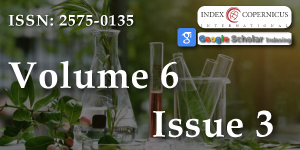Assessment of indigenous methods of shea butter processing among rural women in Borgu Local Government Area of Niger State, Nigeria
Main Article Content
Abstract
Indigenous food processing and preservation methods are on the verge of collapse, yet they proved promising and sustainable. The study assessed the indigenous methods of shea butter processing among rural women in the Borgu Local Government Area of Niger State, Nigeria. Specifically, it described the socioeconomic characteristics of respondents, examined the shea butter processing techniques used and identified the information sources of shea butter processors in the study area. A multistage sampling technique was used to select 100 respondents. Descriptive (such as frequency count, percentage, charts and tables) and inferential statistics (such as Pearson correlation and chi-square) were used to analyze the data. Findings showed the mean age of respondents was 45.61 ± 11.82, with mean years of experience of 20.39 ± 12.96, the majority (85%) were married and the major sources of information on indigenous shea butter processing came from family members and friends. At p ≤ 0.01 there was a significant association between respondents’ usage of indigenous methods and their marital status (χ2 = 84.24; p ≤ 0.01), membership in cooperative society (χ2 = 40.43; p ≤ 0.01), and community membership (χ2 = 53.21; p ≤ 0.01). However, there was a significant relationship between respondents’ usage of indigenous methods and household size (b = 0.290; p ≤ 0.05), quantity produced (b = 0.616; p ≤ 0.10) and annual income (b = -0.765; p ≤ 0.05). It was concluded that indigenous methods of processing shea butter are widespread among respondents; knowledge is acquired through family and friends. Among others, the study recommends that extension agents be posted to rural areas to educate rural women and build on their indigenous knowledge of processing shea butter to introduce high-quality butter.
Article Details
Copyright (c) 2022 Sani I, et al.

This work is licensed under a Creative Commons Attribution 4.0 International License.
The Journal of Plant Science and Phytopathology is committed in making it easier for people to share and build upon the work of others while maintaining consistency with the rules of copyright. In order to use the Open Access paradigm to the maximum extent in true terms as free of charge online access along with usage right, we grant usage rights through the use of specific Creative Commons license.
License: Copyright © 2017 - 2025 |  Open Access by Journal of Plant Science and Phytopathology is licensed under a Creative Commons Attribution 4.0 International License. Based on a work at Heighten Science Publications Inc.
Open Access by Journal of Plant Science and Phytopathology is licensed under a Creative Commons Attribution 4.0 International License. Based on a work at Heighten Science Publications Inc.
With this license, the authors are allowed that after publishing with the journal, they can share their research by posting a free draft copy of their article to any repository or website.
Compliance 'CC BY' license helps in:
| Permission to read and download | ✓ |
| Permission to display in a repository | ✓ |
| Permission to translate | ✓ |
| Commercial uses of manuscript | ✓ |
'CC' stands for Creative Commons license. 'BY' symbolizes that users have provided attribution to the creator that the published manuscripts can be used or shared. This license allows for redistribution, commercial and non-commercial, as long as it is passed along unchanged and in whole, with credit to the author.
Please take in notification that Creative Commons user licenses are non-revocable. We recommend authors to check if their funding body requires a specific license.
Adesiji GB, Olarewaju KD, Olaleye RS, Komolafe SE. Assessment of indigenous methods of processing shea butter among women in Ilorin East local government area of Kwara State, Nigeria. Journal of Agricultural Sciences (Belgrade). 2015; 60(2): 199-210.
Issahaku H, Al-Hassan R, Sarpong DB. An analysis of allocative efficiency of shea butter processing methods in the northern region of Ghana. Journal of Development and Agricultural Economics. 2011; 3(4):165-173. http://www.academicjournals.org/JDAE
Okullo JBL, Omujal F, Agea JG, Vuzi PC, Namutebi A, Okello JBA, Nyanzi SA. Physico-chemical characteristics of Shea butter (Vitellaria paradoxa CF Garten.) oil from the Shea district of Uganda. African Journal of Food Agriculture Nutrition and Development. 2010; 10(1).
Grenier L. Working with indigenous knowledge: A guide for researchers. idrc. 1998.
Issahaku H, Sarpong DB, Al-hassan R. Evaluating the viability of shea butter production: A comparative analysis. Research Journal of Finance and Accounting. 2012; 3.

